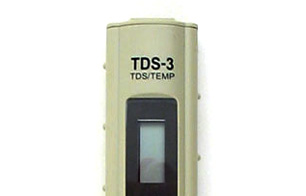Total Dissolved Solids (TDS)
| EPA Secondary Drinking Water Standard |
500 mg/L (≈ 30 grains) |

TDS can be easily monitored with a handheld tester.
| Fresh | <1,000 ppm TDS |
| Brackish | 1,000-5,000 ppm TDS |
| Highly Brackish | 5,000-15,000 ppm TDS |
| Saline | 15,000-30,000 ppm TDS |
| Sea Water | 30,000-40,000 ppm TDS |
| Brine | 40,000-300,000+ ppm TDS |
TDS, total dissolved solids, are defined by a leading maker of test equipment as follows:
Total Dissolved Solids (TDS) are the total amount of mobile charged ions, including minerals, salts or metals dissolved in a given volume of water, expressed in units of mg per unit volume of water (mg/L), also referred to as parts per million (ppm). TDS is directly related to the purity of water and the quality of water purification systems and affects everything that consumes, lives in, or uses water, whether organic or inorganic, whether for better or for worse.
TDS Regulation
-
The U.S. EPA sets the maximum contaminant level for TDS at 500 ppm.
-
The World Health Organization (WHO) sets the maximum contaminant level for TDS at 1000 ppm.
In reality, many city water departments are in violation of the suggested TDS level because there is very little city water departments can do to reduce TDS.
TDS Testing
For practical purposes, small handhell TDS meters do an excellent job of reading TDS. The most common use for TDS meters is in the verification of the performance of Reverse Osmosis units. Typically , Reverse Osmosis rejects 90% plus of the total dissolved solids, so with a tap water TDS reading of 200 ppm, a reverse osmosis reading of 20 or less would be expected.
Most fresh water that is consumed by humans falls in the <1000 ppm category. To the right, a table shows how the Water Quality Association ranks water according to TDS.
Photo source: Pure Water Products, author: Joe Franks
Site Index
Filtration Systems
- Aeration for Iron & Sulfide
- Backwashing Filters
(whole house & well units)
- Chlorine & Chemical Injectors
- Countertop Water Filters
- Emergency Filters
- Garden Hose Filters
- Reverse Osmosis, Residential
- Reverse Osmosis, Commercial
- Shower Filters
- Specialty Filters
- Ultraviolet Systems
- Undersink Filters
- Water Softeners
- Whole House Filters
Cartridges
Parts
- Replacement Parts
- Faucets
- Filter Media
- Fittings
- Housings
- O-rings
- Pumps
- Pura UV
- R.O. Parts
- R.O. Tanks
- R.O. Booster Pump
- VIQUA UV